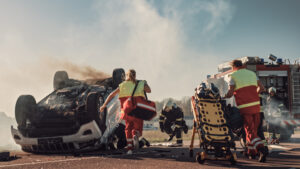Some good advice for your Halloween. The law firm of Kraft & Associates has posted safety tips in a helpful article on this eve of the big day. Before you suit up, read on. Halloween can be a very enjoyable time for kids and adults if “trick-or-treating” is done sensibly.
From Texas comes some good advice for your Halloween. The law firm of Kraft & Associates has posted safety tips in a helpful article on this eve of the big day. Before you suit up, read on.
Halloween can be a very enjoyable time for kids and adults if “trick-or-treating” is done sensibly. However, parents and children should always remember basic rules of safety and be aware that there are some people who tend to go too far with pranks and mischief. Don’t let those people ruin your fun. Trick-or-treating is for kids, so keep these guidelines in mind.
A responsible adult or teenager should be with the kids. Kids should go out in groups Try to limit the groups to four or five members if possible, and know who is in each group. If a child thinks he or she is too old to be accompanied by an adult or teenager, he or she is probably too old to be trick-or-treating. Organized parties are one possible alternative to trick-or-treating for older kids (younger children may enjoy this activity, also.)
COSTUMES
Halloween costumes come in many shapes, sizes and styles. Discuss what type you or your child will be wearing, then whether you buy it or make it, incorporate safety into it. Here are some aspects to think about:
1. Is it too binding, or does it allow freedom of movement?
2. Is the footwear too big? This could cause tripping, stumbling, ankle twisting, etc. Your regular street shoes would be best.
3. Some costumes have capes, hoods, and/or attachments which could snag, trip or otherwise cause problems.
4. Anything that is part of the costume, such as swords etc., should be made from flexible material and have a definite appearance of being imitations that are not capable of harm.
5. Rather than using a mask that could block vision, use face paints, or makeup.
6 Costumes should be made of white or light colored materials or have some type of reflective tape, patches, or strips attached. Fire retardant materials are also recommended.
TIPS FOR KIDS
1. One person in each group should carry a flashlight, and preferably each member should carry one. If you carry a flashlight, use it.
2. Never eat anything until after you are home and the treats have been examined.
3. Carry trick-or-treating bags or containers that have handles. This allows free movement of arms.
4. Stay in your own neighborhood and only go to houses which have porch lights turned on.
5. Walk, don’t run.
6. Stay on sidewalks and don’t cut through yards.
7. Try to avoid dark areas and stay in lighted areas.
8. Keep your distance from strangers.
9. Look both ways before crossing streets.
10. Don’t go into a stranger’s house.
TIPS FOR ADULTS
1. Cut and wash fruit before eating. Throw away anything unwrapped. Check wrappers of commercial treats for signs of tampering. Notify police if harmful items are found. Encourage your kids to eat before going trick-or-treating to help them avoid the temptation of snacking on their treats before you check them. Do not invite trick-or-treaters into your residence.
2. Do not leave your home unattended on Halloween night.
3. Do leave your porch light on as a signal to children that it is O.K. to trick-or-treat at your residence.
4. Keep your pets inside on Halloween night.
5. Know the route your children intend to take and impress on them the importance of following it.
6. Report suspicious activities such as mischief, bullies or trouble makers to the police.
Have a fun and safe Halloween!
Information taken from: “A Word to the Wise About Halloween Safety” Irving Police Department Community Services Section, Crime Prevention Unit

The Legal Examiner and our Affiliate Network strive to be the place you look to for news, context, and more, wherever your life intersects with the law.













Comments for this article are closed.